WHAT YOU LEARN AT JIULONG BAGUAZHANG SCHOOL
Our classes are structured to provide a simple step by step guide to developing skills. The health and martial practices are branches of the same tree and there is considerable overlap in the content of each class. All students learn the same fundamental principles of relaxation, mental imagery, posture, and body mechanics. Beginning students can enroll in our Mindbody Health class, our Baguazhang Basics (martial) class or both. Once martial students have completed our introductory program called Dragon Rolling the Pearl, they go on to study each of the Jiulong Palms. What follows is an outline of what you will study in our health and martial classes.
 |
Yi Xin Gong Intention Attitude Skill is a loose English translation for Yi Xin Gong (YXG), a form of training unique to Jiulong Baguazhang. YXG involves the use of sense memories. Recalling the smell of fresh baked bread or the sensation of being in water are examples of sense memories. Students practice “feeling as if” they are performing a physical action such as pulling or pushing using their sense memories of performing these actions. Such practice activates the central nervous system and reinforces the pathways along nerves that signals must travel to reach the muscles performing the action. It can be likened to a form of mental rehearsal. This produces increased strength when actually performing the action. When YXG is combined with physical training, the result is significantly increased speed, power, and coordination. Well-trained Jiulong students will have learned how to feel as if they are engaged in actual combat while practicing, feel as if they are soothing their own muscles with sensations of warmth (or coolness) and relaxation, and change their spirits with the emotional attitudes of Jiulong’s 8 Palms. While this may seem like some form of mystical practice, it is anything but. Mental rehearsal using imagery to increase muscle strength and physical performance has become a well-established tool. Based on neurocognitive research, it is applied in sports, law enforcement, and military training and similar mental techniques are widely used by sport and clinical psychologists. YXG is a step by step approach to using the mind to become better. |
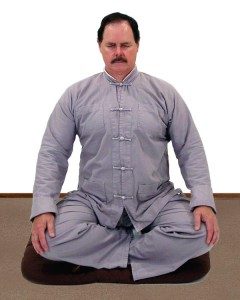 |
QUIET SITTING We practice quiet sitting in every class. It is fundamental to the art of Jiulong and is the gateway to the cognitive/emotional training methods that develop health, skill and power to an amazing degree. Even though the practice involves relaxing the muscles, attentive diaphragmatic breathing, and sitting still (on a chair, in a lotus posture or in a za-zen position), it is not exactly meditation. The mind remains active and beginners perform various mental exercises to enhance concentration and relaxation of mind and body. The goal of quiet sitting is to develop the ability to recreate physical sensations in the body whether they are for enhancing health or combat skill. It is, in effect, a method of training the nervous system directly from consciousness without the need for an actual movement. This requires the ability to stay relaxed and focused at the same time. |
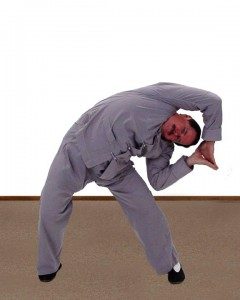 |
DAOYIN The word daoyin can be roughly translated from the Chinese as “to lead or guide”. In our system, we use it as a name for a series of Tibetan/Daoist yoga exercises, performed mindfully, slowly and consecutively, to move the spine, shoulders, and hips through their physiological ranges of motion. Much more than simple warm-up stretching exercises, although they do that very well, the movements are of the same kind the student will use at all levels of training. Repeated practice lays a neurological foundation (some may call it ‘muscle memory’) for moving like a Jiulong Baguazhang player and it continues training the same awareness and relaxation skills as practiced in quiet sitting.
|
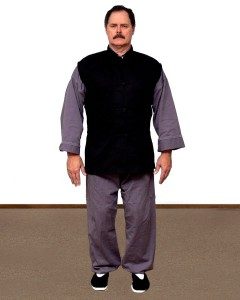 |
POWER STANDING (Zhan Zhuang) The human body is structured to stand and move in the upright position. It can assume many different postures of course, but there are optimal postures for performing the tasks of day to day life as well as those required in personal combat. Jiulong students learn to stand upright and hold postures, releasing all unnecessary tension while keeping the spine in a neutral position; i.e. the posture that minimizes mechanical stress on the neck and back and optimizes the ability to lift, push, pull, and move. Standing practice also continues the development of relaxation and imagery skills started in quiet sitting. Zhan Zhuang, the Chinese term for standing practice, can be considered a form of meditative training in which students learn to focus and move their attention around in the body, as well as create physical and emotional sensations such as lifting a heavy weight and feeling powerful. Consistent practice strengthens the body’s ability to stay upright, leading to less fatigue when sitting and standing while strengthening the mind’s ability to control the body. |
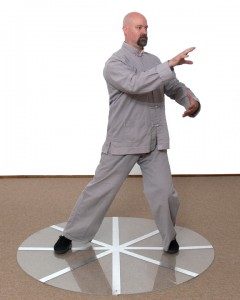 |
SHIFTING If Jiulong standing practice is about learning to create a stable and strong structure of your body, then shifting practice is about learning to move that structure using the power of the legs. When we shift our weight to perform a physical action, be it pulling open a heavy door or throwing a punch, we also have to coordinate movements of the rest of the body in order to use the strength of our whole body to perform the task at hand. This is what we practice when we practice shifting in Jiulong to develop efficient, coordinated, and stable movement. It is made even more powerful with the addition of YXG practice as we move. For martial students, the practice is key to learning how to use the hand, elbow, shoulder, and torso to strike with the weight of the whole body behind it |
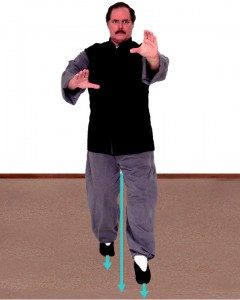 |
LINEAR WALKING According to Li family oral history, Jiulong’s distinctive method of walking was developed to contend with multiple attackers carrying a variety of weapons on different kinds of terrain as might be encountered by the trade caravans they guarded in northern China. Using the lessons learned from sitting, standing, and shifting, students learn to step, holding and changing postures in a relaxed coordinated fashion. This walking method utilizes all the leg muscles to propel the body horizontally through space with little to no impact. Students are trained to maintain knee-toe alignment to allow for maximum muscle coordination (and hence power) while protecting the knees from twisting and being damaged. The Jiulong gait also allows rapid direction changes that conserve and add to the body’s momentum. These features make it an excellent and safe form of aerobic exercise that strengthens the legs and improves balance while reinforcing posture, coordination, and body awareness. Martial arts students learn to cover ground and change directions quickly, evading attacks from any direction, all while being able to deliver powerful strikes with different weapons and/or different parts of the body. |
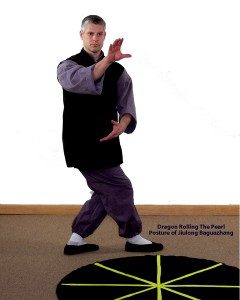 |
CIRCLE WALKING Walking the circle is Baguazhang’s celebrated iconic training practice. In the Jiulong Baguazhang system, a student stepping into the circle for the first time has already been introduced to mental focus/imagery training as well as muscular control achieved through relaxation, posture training, and coordinated movement of one’s entire mass. All human cultures have dances and rituals that involve moving in circles and there is at least some evidence to suggest that moving in circles has a particularly calming effect on brain activity. Circle walking also challenges the vestibular system and repeated practice likely improves balance and stability. From a purely practical point of view, it can be practiced in a relatively small space, indoors or out. It is in the circle that the lessons learned from sitting, standing, shifting, and stepping come to full fruition. Continuous, fluid movements of the arms and torso in harmony with the power of the legs adds to the aerobic effect of walking and engenders a calm, aware mind. Students practice the techniques of YXG to enhance training effects whether they are meant to promote health or martial skill. Because Jiulong Baguazhang has no fixed forms, each circle walking experience can be different depending on what the student wishes to practice. It might be a mindbody healing exercise or it might be a pantomime of combat but either way, the ultimate goal of circle walking is to flow with the Dao and become one with nature. |
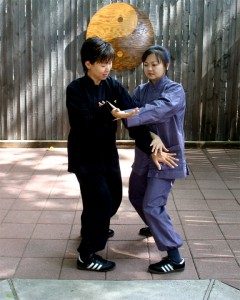 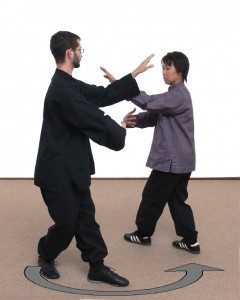 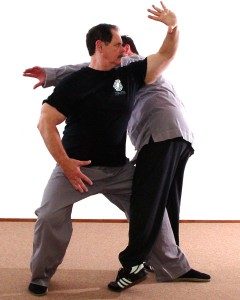 |
APPLICATIONS The goal of Jiulong combat training is survival, not victory. We believe strongly that martial training should be cooperative and not competitive for students to optimize skill. It requires us to leave our egos at the door. The training discussed above develops skills that have great value in themselves because of their benefits to emotional and physical well-being. But if any kind of martial proficiency is the goal, then the student must learn to apply those skills to that end. In Jiulong’s martial training, partner practice and equipment training are used to teach distance, timing, and principles of attack and defense with repetitive drills and martial games. Willow Bends (Rou-Liushu) involves 2 partners facing each other closely enough to touch forearms. They are allowed only to shift from side to side as each tries to get the other off balance by finding weaknesses in the other’s structure and effortlessly using the power of the entire body to force a partner to take a step. It is a sensitivity exercise that puts pressure on the student’s ability to maintain a stable structure under dynamic conditions and accustoms the student to physical contact. In Two Dragons at Play (Shuang Long Xi), partners circle around each other, learning to make and break physical contact smoothly, maneuver, and initiate or defend against attacks while moving continuously, applying the lessons of Willow Bends. Free Play (Anzhang-Fa) takes the above training games fully into the realm of ever-changing spontaneous action required in personal combat. Deflections, strikes, locks, and throws are practiced with increasing speed and power while moving constantly. At combat speeds, protective equipment is required. Equipment Training teaches students how to develop speed and power for martial applications through the use of heavy bags, speed bags, striking pads, and posts. A practitioner may use equipment traditionally, standing in front of a bag and hitting it or start the bag swinging and then circle around it, trying to strike effectively on the fly while changing directions. There are many ways equipment can be used to train the specific methods of all 8 Palms. The diligent student eventually learns how to use everyday things as training equipment. A favorite example is the Jiulong instructor who dodges around moving swings in the park where he takes his boys to play. Your instructor will guide you in these methods to suit your own particular needs. |
CLASS STRUCTURE
We believe that consistency is the key to maintaining high quality teaching and preservation of the art. A certified instructor has undergone years of rigorous training and testing to be able to teach and is bound by honor to follow the curriculum outlined above. All Jiulong Baguazhang classes are structured as follows and a Jiulong student is meant to feel at home when visiting different schools in different cities and countries. Below is the outline of how all classes are run.
1. Bow on entry to training space (Required)
2.Ring Gong, Bowl or Tingsha (Required)
3. Sitting (Required)
4. Daoyin (Required)
5. Standing (Required)
6. Review (optional)
7. Lesson of the day (Required)
8. Practice time (optional)
9. Any discussions or philosophical readings (optional)
10. Class Announcements (Required)
11. Recite Four Virtues (Required)
12. Bow Out (Required)
PHILOSOPHY
On a more informal level, students are also regularly exposed to concepts and symbolism deeply embedded in Chinese culture for millennia. Many have also become influential in Western philosophical thinking. These concepts and symbolism were part of the lives of those who developed several Chinese internal arts and influenced how they described the process of learning their art. This included the Li family who created Jiulong Baguazhang.
Jiulong students become familiar with Daoist concepts related to change and conflict. They learn the Yijing’s ideas about the forces of nature relevant to preserving health and life. Sun Tzu’s famous “The Art of War” is a highly recommended text alongside the Daodejing (Tao Te Ching) and other Daoist and Buddhist works. For those interested in the spiritual path, the Li family philosophy called Xinfudao offers a view on life that is a blend of Tibetan Buddhist and Daoist ideas.
If you are a prospective member or student of any of our schools and have any concerns, please feel free to contact us at Thegompa@aol.com We will be happy to help you.
